By Wednesday of this week, the wonderful migration we enjoyed this month had indeed passed by, at least for warblers, although some shorebirds are still moving. After we left Joppa Flats and headed south on Plum Island, we only paused a few times on our way to Sandy Point. We slowed for a few Gadwalls and some peeps in the pannes, and we did enjoy seeing some Black-bellied Plovers that were foraging in the South Marsh. They were not on a flat of sand or mud, where we usually find them, but were foraging in salt hay. Most of them were in breeding plumage, looking striking poking out of the grass, like exotic creatures on a miniature savanna. At the parking lot on Sandy Point, we clustered together to quiet down and listen to the warblers and other birds singing around us. Mostly we heard Eastern Towhees, Yellow Warblers, and Common Yellowthroats. Last week was different!

Black-bellied Plovers and Rudy Turnstone foraging in salt marsh- Patti Wood
Walking out toward the Point, we briefly spotted a few Bank Swallows that may be nesting on a dune well to the west of the parking lot. They do not seem to have a colony at Bar Head this year as they have in the past, due perhaps to significant erosion of the headland there resulting from the March storms. We soon found Piping Plovers, especially because Jessica McClean, the plovers’ conservation staff member from the Mass Audubon Coastal Waterbird Program, was there counting nests. I use the possessive there, because the plovers benefit greatly from the actions of these dedicated summer staff. They keep track of the birds, educate the public, and encourage visitors to help the birds thrive by giving them space to roam – and keeping pets away. Jessica told us that there have been nine nests on the point this year, and that seven of them have not worked out… yet. They were lost to crows, coyotes, and unknown causes. We were happy to see plovers courting and renesting. One male attended a female at a nest she was excavating, and then followed her in a ritualistic crouch, with back feathers raised. Good luck, guy!
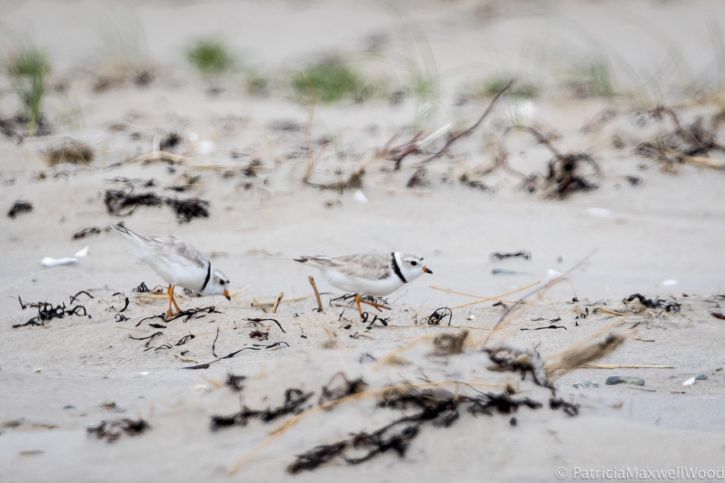
Piping Plovers vying for dominance – Patti Wood
Birds that nest just above the high tide line often have nest losses due to myriad disturbances, so they have evolved a high degree of persistence in making new nests, sometimes up to four attempts. As many as six Least Terns were hanging around and courting, indicating they may nest at Sandy Point this year, up from zero last year, when a spring storm wiped away most of the available wrack-strewn habitat the terns need. Jessica told us that she has found many more of them at the north end of the island, more than ever before. We enjoyed seeing them flying over, making their squeaky, insistent calls.
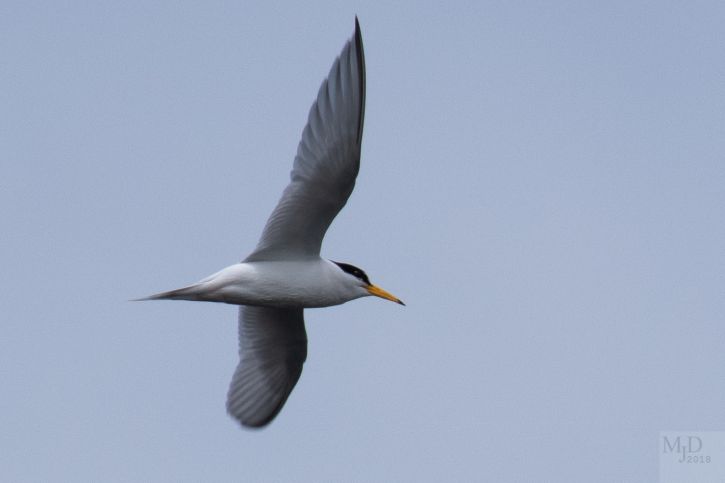
Least Tern – Mike Densmore
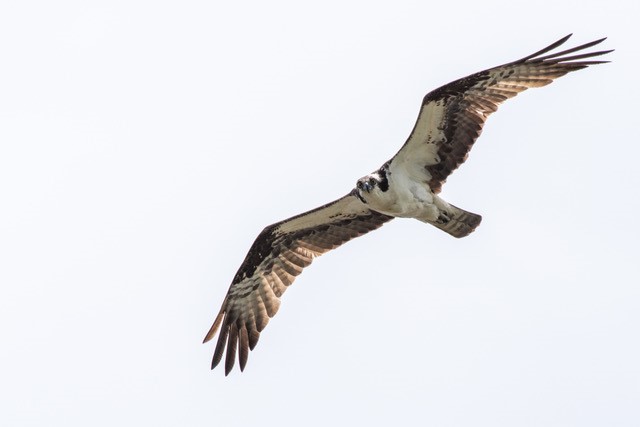
Osprey – Bob Minton
Bemused by all that plover love, we headed back to find what might be available at Hellcat. Seeing the Black-bellied Plovers flying and alighting repeatedly in the marsh, we pulled over for another look and found three Ruddy Turnstones in with them. At Hellcat, we hoped to find a Baltimore Oriole nesting near the restrooms, but none was about that morning, and we all felt a bit sad that there seemed to be no “Hellcat Johns Oriole” this year. We continued up to the dike, where Bobolinks were singing on the outer dike. They made display flights just as they would in any field, and appear to have colonized the strip of deep vegetation on the banks. An Osprey flew over, almost a sure thing on the Hellcat Dike for the next month or so. A flock of 200 or so Semiplamated Sandpipers made beautiful dashes over the newly exposed flats in Bill Forward Pool. John Linn aptly referred to his image of them as a “shorebird cloud,” and accepting that label, we now have one of the fastest clouds on earth. This is just a taste of the joys of shorebirding we will revel in later this summer, for when southward-bound shorebirds return in mid-July, their numbers will eventually grow into the thousands. Those are cloud-dances not to be missed!

Shorebird cloud – John Linn

Empidonax sp. – Bob Minton
We continued to poke around, looking for any birds that might present some diversity or a good show. Two Empidonax flycatchers made a nice little show at the east end of the dike, but neither ever uttered one phrase. So, we had to believe in our hearts that they were Willow Flycatchers, as we have heard their “Fitz-bew!” repeatedly at the spot on recent visits. Without a sound, then and there though, we will only name the genus.

Spotted Sandpiper – Mike Densmore
As you can see from our list below, we ran into many more species than I’ve mentioned, but it was a scattering of the breeders we always expect on Plum Island in summer. I will, however, mention the Northern Mockingbird that sat on a post at the exit from Hellcat. That bird sat staring at us, and evidently at everyone else who was departing behind us. Such a character!
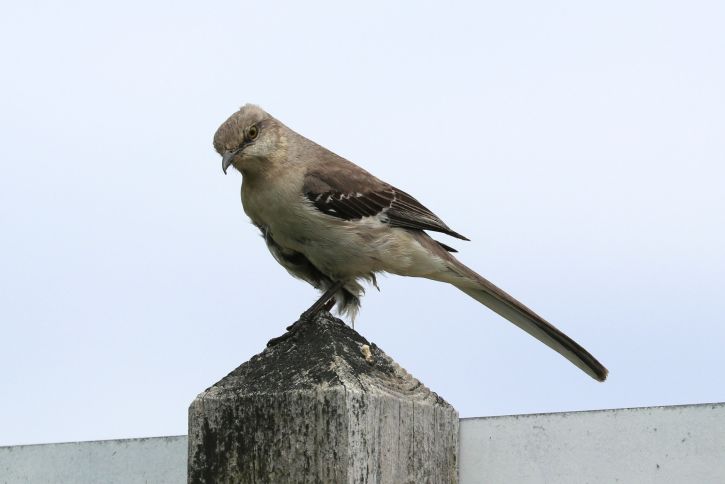
Northern Mockingbird – John Linn
I will also note here that on our later walk for Wednesday Evening Birding, we found two gorgeously bright male Baltimore Orioles in an amazing dispute right in the forest behind the restrooms at Hellcat, so our fears that morning were unwarranted. Those two fellows hopped around from branch to branch within inches of each other at times, showing off the best plumage they could muster and singing at one another. That was an eyeful! Lastly, the Orchard Oriole nest we observed being constructed last week is still occupied in a pine to the north of Goodno crossing. We hope you find that pair!
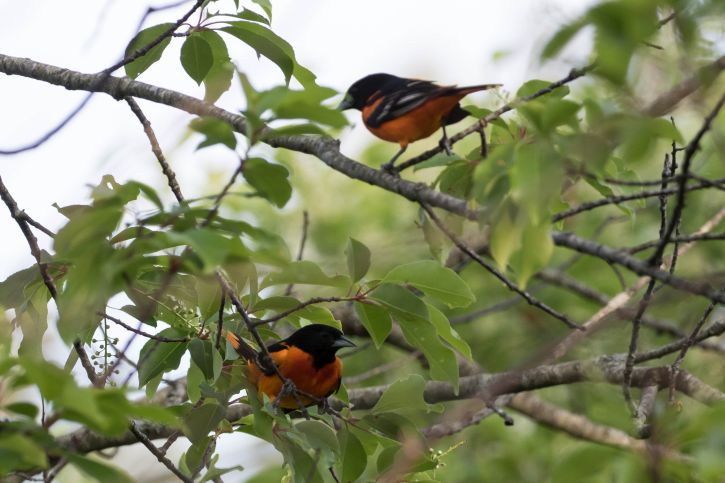
Baltimore Orioles – David Moon
Our list:
Canada Goose (11) – including a pair. w/ 6 good-sized goslings; Bill Forward Pool.
Mute Swan (1) – adult, southern-most panne.
Gadwall (3) -lone drake, pannes; pair Bill Forward Pool.
Mallard – many including molting drakes, Stage Island Pool.
Red-breasted Merganser (1) – hen, Stage Island Pool.
Wild Turkey (1) – tom, South Field.
Double-crested Cormorant – common.
Great Egret (~ 5)
Snowy Egret (~ 7)
Osprey (1) – overhead, Bill Forward Pool.
Black-bellied Plover (~ 25) – 2, Sandy Point; balance, South Marsh.
Semipalmated Plover (5) – 3, Sandy Point; 2, Bill Forward Pool.
Piping Plover (~ 9) – Sandy Point.
Killdeer (2) – 1, pannes; 1, Sandy Point.
Spotted Sandpiper (1) – Bill Forward Pool.
Willet – common.
Ruddy Turnstone (3) – w/ Black-bellies; South Marsh.
Semipalmated Sandpiper (~ 200) – Bill Forward Pool.
Herring Gull
Least Tern (5) – 1, main panne; 3, Sandy Point; 1, Bill Forward Pool.
Common Tern (1) – Sandy Point.
Mourning Dove
Empidonax sp. (2) – together in small trees and shrubs southeast corner North Pool, Hellcat dike; probable Willow Flycatchers.
Great Crested Flycatcher (1) – heard, north end S-curves.
Eastern Kingbird (3) – various.
American Crow (2)
Purple Martin (~ 7) – lot #1.
Tree Swallow – common.
Bank Swallow (1) – Sandy Point.
Barn Swallow (3)
Marsh Wren – common; North Pool.
American Robin (2)
Gray Catbird – common.
Northern Mockingbird (3) – 1, Sandy Point; 1, Hellcat; 1, lot #1.
Brown Thrasher (1) – roadside, south end S-curves.
European Starling
Cedar Waxwing (2) – Hellcat.
Black-and-white Warbler (1) – heard; Goodno crossing.
Common Yellowthroat – common.
American Redstart (3)
Yellow Warbler – common.
Eastern Towhee – common.
Song Sparrow – common.
Northern Cardinal (1)
Bobolink (6) – 1, North Field; 5, vicinity of Bill Forward Pool dike.
Red-winged Blackbird – common.
Common Grackle – common.
Brown-headed Cowbird (4)
Baltimore Oriole (2) – 1, Hellcat; 1, Goodno crossing.
Purple Finch (2)
American Goldfinch (2) – Sandy Point.

